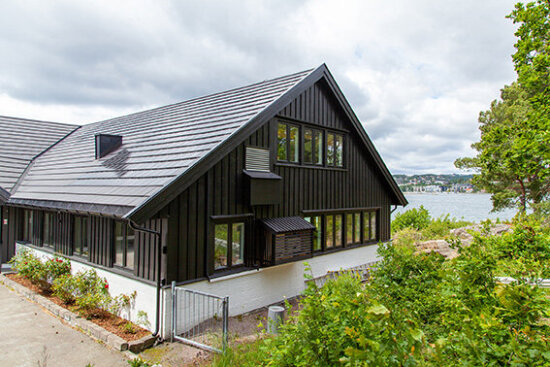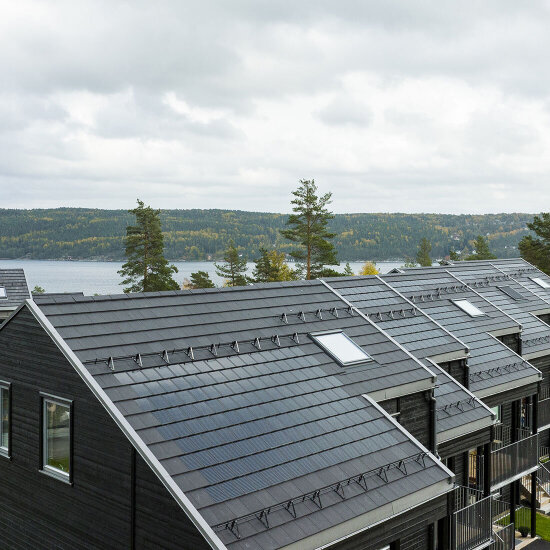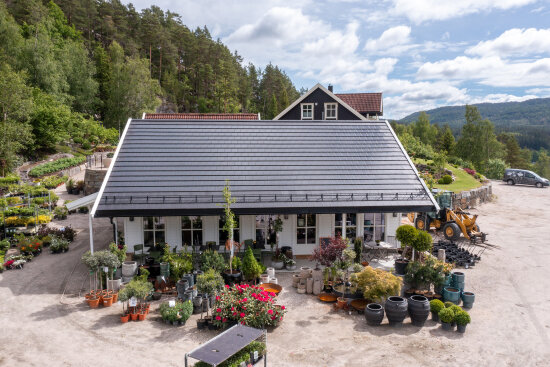OVATI™ are the world’s first concrete roof tiles with integrated solar cells. They provide a robust and beautiful pitched roof which produces electricity, are adapted to a Nordic climate, have low maintenance costs and a long life.
Power is vital to all development, but it is also a limited resource largely produced from fossil fuels. Expansion of the power grid leads to massive disturbances to the natural environment and huge costs. Utilising roofs to create electricity is one of many measures that can contribute to a more sustainable energy production.
OVATI™ has the solution. Roof tiles have for a long time been used all over the world because they protect buildings, are long-lasting and aesthetically pleasing, and can be adapted to local building traditions. OVATI™ combines the roof tile technology of Skarpnes with solar energy to allow householders to produce their own electricity.

Photo: OVATI ™
A three-way collaboration that yielded results
The story began in 2014. Morten Meier chanced upon the German solar cell manufacturer, Autarq, during a visit to the Moselle Valley in Germany. The long-established roof tile manufacturer Skarpnes in Grimstad was curious about solar cell technology, and it was Meier who later established contact between the companies. Meier himself established the company Sun-Net and became a part of the development process.
OVATI ™ roof tiles are adapted to a Nordic climate. They are based on one hundred years of product development and are a result of innovative collaboration.
The three-way collaboration resulted in production of the first pilot of Ovati solar cell roof tiles in 2019. They were launched as a commercial product in 2021.
In the same year, Skarpnes was given a EUR 2.4 million development grant from the EU-fund Fast Track to Innovation (grant agreement 970958). The funds constitute international recognition and will be used in a research and development project with the aim of becoming the new standard for solar cell solutions for traditional roofs throughout the EU.

Photo: OVATI ™
Income from the roof
One of the advantages of OVATI™ is that they are suitable for both new and refurbished buildings. By producing its own electricity, it will take a household around ten years to pay off the investment. The roof tiles have a life of between 30 and 40 years, which means the roof will yield income for at least 20 years. When the solar cells are no longer active the building will still have a fully functional traditional roof.
If many people install electricity-producing roofs this will also have a socio-economic benefit. Compared with other renewable power sources such as water and wind, there will be less disturbance to the natural environment, no sound pollution and no transport or grid costs. Electricity-producing roofs have low running costs and can be gradually developed, one roof at a time.
Skarpnes are actively working to get as many of their roof tile customers as possible to choose OVATI™. In parallel with these efforts, as the coordinator of the EU-funded development project Tile Plus, the company is working to include other suppliers in future solar cell solutions.
Brief facts about the project
OVATI™: Norwegian roof tiles with integrated solar cells
By: Skarpnes AS, Sun-Net AS and Autarq GmbH
Design discipline: Industrial design
Recipient of the DOGA Award
This prosject has received the DOGA Award for Design and Architecture for its outstanding qualities and for showing how strategic use of design and architecture create important social, environmental and economic value.
These are three reasons why this is an exemplary project:
- Super local electricity production
More solar energy contributes to increased electricity production in Norway and reduces the use of fossil fuels. By producing your own electricity, you free up capacity on the grid and help to reduce the need for infrastructure development and disturbance to the natural environment.
- Manufactured in Grimstad
The roof tiles are manufactured in Grimstad. The main raw material is sand, which comes from local sand quarries and therefore does not have to be transported far. Integrating the solar cells in the roof tiles saves on material, rendering an aluminium frame unnecessary. - Collaboration for innovation
The roof tiles are a result of collaboration between the University of Ålborg and three companies in three countries. In addition, the manufacturer Skarpnes collaborates with Innovation Norway and with the EU over funding and scaling of the technology. The project embraces both public and private actors in three European countries.


